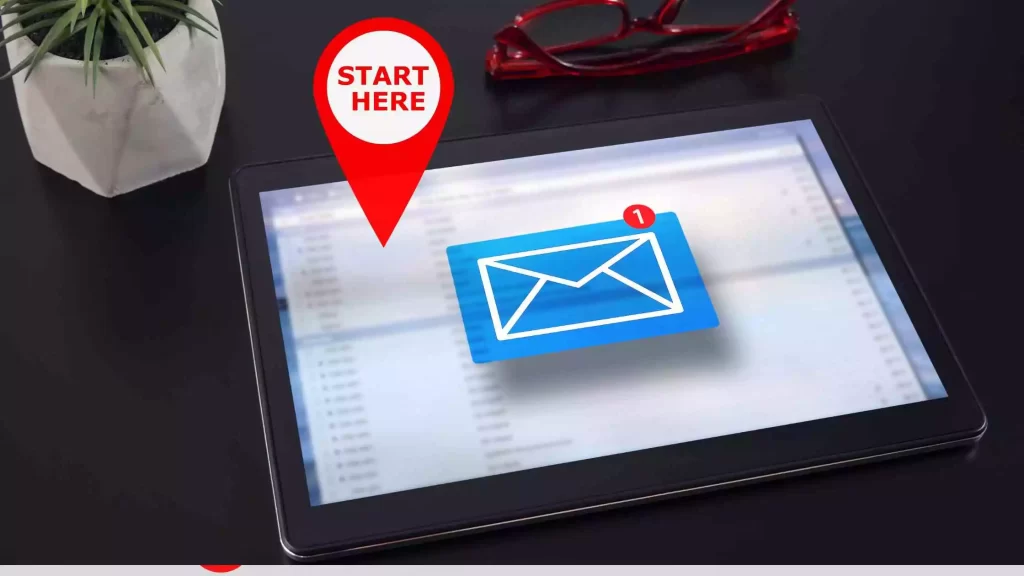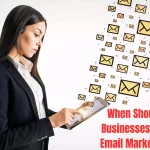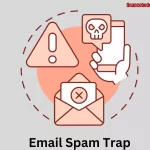Do you want to start email marketing and don’t know how to get started?
Worried about whether you can make it?
Do you have more questions than answers in your head?
Email is still among the tools with the best results. $38 is returned from one dollar invested, i.e., a return of 3800%. (source constantcontact.com).
It is clear to self-employed persons and small enterprises that they should concentrate on email marketing, but they do not have the same possibilities as major firms. They have their own marketing teams or might hire organizations specializing in emails.
Take a look at the short guide, in which you will discover what is excellent to concentrate on and what, on the other hand, is not that vital.
How to get started with email marketing
Surely you have already got an email in your mailbox.
So you may already have an idea of which emails you appreciate and which bother you. How are the ones written that you read and that interest you?
You also absolutely get ones you don’t even read. They fall under “spam.” Or you simply rapidly scan them with your eyes and promptly “dump” them. Our data overall suggest that such emails are the majority.
You may be interested on how to prevent your email from going to spam.
You may leverage all these personal experiences from what you read and acquire in your company. Specifically to the emails that you will generate and send.
1. Set your objectives
Email marketing shouldn’t simply be a shot in the dark. It should fit with the entire marketing strategy and plan.
So don’t go for a shortcut, and don’t start sending even one email until you are fully clear about what you want to accomplish. Set your objectives. It isn’t very interesting, but essential.
What do you want your email marketing initiatives to achieve?
- Increase sales?
- Expand your contact database.
- Promote your own brand?
- Attract more customers to your website or a business, restaurant, or cafe.
The aim is vital, to begin with, since (not just) the content of emails is different for each of them.
And above all, measure the objectives
In addition to outlining what you want to accomplish, explain to yourself how you will measure it. (I don’t need to tell you that a well-established objective is quantifiable.)
This gets you “feedback” from your email receivers. And you will then utilize such outcomes to enhance additional initiatives.
Whether you name the figures KPI (Key Performance Indicator) or anything else, in the case of email marketing, emphasis on opens, clicks, deliverability, unsubscribes, or simple conversions.
Track what is essential to you and attain your objective. When you want to enhance sales, actual data are vital, while the open rate itself is not that significant.
2. Put up a database of contacts
Now comes the true “hard work.” Put together the contacts to whom you will send your emails.
If you are not at the very beginning of your company, then you already have the foundation of such a database. These are client contacts who have submitted an inquiry or met with them in person. You have their business cards.
Create a basic spreadsheet in Excel, Numbers, or Google Spreadsheets. Write all the contacts in it. An email address or name is sufficient for greater personalization.
When you add the contacts to the table, split them into multiple groups. There are essentially two categories. Customers (have previously purchased something) and prospects (have not yet bought but are interested in what you do). Only then add more if required.
Make sure that they are all individuals who know you. That is, they know your firm and its goods or services. This is to guarantee that you do not run afoul of privacy rules and legislation that control the transmission of commercial messages.
The database is continually alive
Contacts of individuals who know you form the backbone of your database. Expect that from time to time. Someone may unsubscribe from your other emails. There will be quite a few for the first newsletter. That’s alright, and it can’t be avoided well enough.
Therefore, continually replenish and increase the database. A decent database is actually a gold mine. Therefore, certainly, avoid purchasing one.
It is best to develop your database with your own actions, even if it happens slowly. You will then have individuals in it who are interested in what you do.
Some examples of ways to expand the database are as follows:
- Magnet form on the website
- Incentives (discounts for the first purchase, free sample) (discounts on first purchase, free sample)
- Promotion on social networks (paid/unpaid)
Generally known as Freebie or lead magnet
3. Promote your brand
Pay attention to what your brand is. How you communicate. What is essential to you? What makes you distinct and remarkable? And apply that branding to your email marketing.
It’s not the most important item for the first email, but eventually, you will discover that the brand is vital. And not simply from the point of view of email templates. A brand is not merely a corporate color or a logo.
It is the sensation and pictures the receiver will get when they see your email in their inbox. You want him to recall who sent it to him quickly. Who are you, and what goods or services do you have?
Of course, thanks to the templates, all your emails will seem identical,
4. Prepare the email campaign content
In this phase, think about what you will send. Will it be an informative email on what’s new with you? Will you be sending an invitation to an event? Information on a new product?
There are many distinct sorts of emails, and each has a function. And that’s why it’s crucial to have a purpose in mind before you start generating content.
I absolutely don’t advocate sending sales emails initially. Have you encountered an acquaintance who contacts you after many years and requests money? This is not how you want to impress your connections.
Take it softly and slowly. Send some introduction emails initially to remind your consumers. And let them know that you now aim to email them frequently. Such emails are termed reactivation.
In theory, first be informational, preferably helpful, and then calmly send a sales email with a promotional offer.
Here are a few varieties of emails, depending on their purpose:
- Welcome messages (short introduction of you and your business, confirmation of registration for the newsletter, link to download the magnet).
- Content emails (used for branding, link to fresh blog piece, a tale of your customer, beneficial suggestion from your sector).
- Event invites, webinar
- And more
5. Prepare the first newsletter
Use email marketing software to upload your contact database and build an email message.
Focus on content. That one is essential. The design comes second.
Don’t be constrained by any sophisticated visual templates. If you care about them, know that you will have ample time for them.
Prepare a brief and precise text. A short message that is easy to understand and illustrates what the primary topic is. People are slow to read, so they first scan it fast, and only if anything attracts them, they read in greater depth.
All the key facts must be heard directly in the introduction. In the first phrase. So skip the long-winded introductions. Get now to the point.
Think of your mailing content as an inverted pyramid. The most crucial thing must be correct from the beginning. And gradually, as the pyramid narrows, include the less critical facts.
Pay special attention to the subject line of your email. The topic determines whether the receiver opens the email at all.
There must be a call to action at the conclusion of every email. Write exactly what the receiver should do after reading the letter. Reply? Click on a link to go to a certain website or blog. Register?
As for the visuals, remember that nearly half of the recipients will open the message on their mobile phones. Therefore, your email must appear nice on mobile.
6. Evaluate the statistics
Sending an email doesn’t end the opposite.
It is vital to find out how your work was effective and if the email accomplished its aim.
If you’re utilizing a decent marketing solution, you should have this data accessible for every message you send.
Focus in particular on:
- Open rate – how many people opened the message
- Click-through rate – how many people clicked on the link in the message
- Deliverability rate – how many individuals the email reached in the inbox
Don’t also forget to check out the following:
- Unsubscribe rate – how many customers unsubscribed from the following subscription
- How many emails were not sent – either because the recipient’s inbox was full or the email address did not exist at all (it was canceled)
By watching the data, you will eventually know for yourself which message was effective and where you “stepped on the wrong side.”
7. Could you test it?
Once you’ve sent your first email messages, you may make your campaigns even better.
Use A/B testing.
This implies that you will produce two copies of the identical email, but they will vary in some manner. For example, in the topic. Send each version to one area of the database.
Then you may examine which topic the receivers reacted to better too. It’s an excellent technique to boost deliverability and openness. And also the incentive for subsequent campaigns.
Use statistics and testing to enhance your emails. Just be cautious. You will never have 100% openness 🙂
What to do after sending
Message delivered, numbers are home, so done? No, you can no longer put your feet up on the table.
Look for a weak place in your campaign to learn from next time.
Figure out what to send to people who haven’t opened the message. Whether it was because they weren’t on email or there was another reason, if you email them again in a few days, possibly with a new subject line, you’ll be astonished at how many will open it.
Remove contacts from your database that have an inaccurate or non-existent email address. It will assist in boosting the deliverability of other messages.
And certainly don’t forget that email isn’t the only medium that can promote your brand and attract new consumers.
Use the material you have generated for emails and performed successfully on social networks in advertising.
Conclusion
Email marketing is not rocket science. Follow tiny but obvious actions, and you will notice actual results.
Email marketing still works. It is still the most effective tool. It provides the best return. Nevertheless, a handful of largely smaller businesses evade it. You may try combining SMS with your email strategy to boost your deliverability rate
It is a pity. Because preparing and sending a mass message is not particularly difficult. Yes, it takes time and practice. Don’t expect to run a marathon straight soon. The first emails are usually more challenging, but if you endure, you will fall in love with email marketing.





